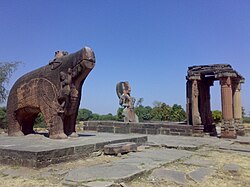Eran (India)
| Eran ऐरण |
||
|---|---|---|
|
|
||
| State : |
|
|
| State : | Madhya Pradesh | |
| District : | Sagar | |
| Sub-district : | Bina | |
| Location : | 24 ° 5 ' N , 78 ° 10' E | |
| Height : | 405 m | |
| Area : | 6.1 km² | |
| Residents : | 1,235 (2011) | |
| Population density : | 202 inhabitants / km² | |
| Eran - Varaha , temple vestibule ( mandapa ) and Vishnu sculpture | ||
Eran ( Hindi ऐरण IAST Airaṇ ) is the current name of a village and a historically significant Hindu temple site in the Indian state of Madhya Pradesh .
location
The village of Eran is a good 78 km northwest of the city of Sagar and about 12 km east of the small town of Mandi-Bamora , which also has a regional train station. From there, Eran can be reached via the slopes with a rented car or bicycle. Not far from the archaeological site flows the Bina , a tributary of the Betwa .
Population and economy
The inhabitants of the village are almost exclusively Hindus and live from agriculture.

history
The history of the temple district of Eran goes back a long way. The old name, also mentioned in an inscription by Sanchi , was Airikina or Erikina . Various Gupta rulers furnished the pilgrimage site, which probably existed before, with buildings and sculptures, all of which were destroyed during the time of the Islamic advance in northern India . During excavation work in the 19th and 20th centuries, a large number of coins were found that went back to around 300 BC. Go back BC. The oldest dated sati stone (see below) comes from AD 510, the youngest from 1910.
Ruin site
architecture
In the formerly important complex, not a single building is preserved in good condition. The vestibule ( mandapa ) and the portal wall of an early Gupta temple were reconstructed from four fluted and relief columns . This resembled the temples of Tigawa (Kankali Devi Temple) and Sanchi (Temple No. 17) , but shows a more developed sculptural decoration on the portal walls and is therefore likely to have been built around the middle of the 5th century. It is unclear whether Vishnu's large sculpture, which was erected in the non-preserved cella area ( garbhagriha ), actually stood there.
Only remains of the foundations are left of other buildings.
Sculptures
The most significant relics in Eran are various sculptures and sati stones that span a period of around 1500 years.
Varaha sculpture
The main attraction of the archaeological site of Eran is a Varaha figure about 3.50 m high and almost 5 m long , carved from a single solid boulder. Varaha (boar) is the third incarnation ( avatara ) of the god Vishnu . In the 5th or 6th century AD, the monolith was remodeled into a Varaha figure and possibly protected by a laterally open but roofed structure.
The massive body of Varaha is covered over and over with small figures of gods, which represent the paramount importance of the main character, i. H. Vishnus, underline. To the side of the head can be seen Bhudevi , who holds on to the tusks of the boar-shaped god.
Garuda column
An upright column, which can be dated to the year 485 by an inscription, is almost 13 m high and ends in a lotus capital, which faces the Varaha figure, is comparatively well preserved. Above the bell-shaped capital there is a block-like tower adorned with four lions, on which stands a figure that is commonly regarded as Garuda , although it has no wings and the hands are not folded in adoration.
Sati stones
About a dozen medieval and modern sati stones with inscriptions, which remind of the widow burning and were found in Eran, are of cultural historical importance . The oldest dates from the year 510, the last from 1910. They provide information about the centuries-old and - despite legal prohibitions - in some cases still practiced today, widow burning. Women who followed their deceased husbands to death were highly honored in India. Even memorial stones and plaques were erected in her memory, whereas other inscriptions almost only contain men's names. The actual place of the cremation was usually elsewhere; there are only a few memorial stones in Eran.
Other sculptures
Other figures of gods from different epochs were also found in Eran - e.g. B. Krishna , Narasimha , Kubera , Chamunda , one Shiva - lingam etc. The latter point out that Vishnu was in Eran not only revered but also from the gods Shivaite environment.
See also
literature
- Michael W. Meister u. a. (Ed.): Encyclopaedia of Indian Temple Architecture - North India, Foundations of North Indian Style. Princeton University Press, Princeton 1988, pp. 33f and 40 ISBN 0-691-04053-2
- Anneliese and Peter Keilhauer: The Imagery of Hinduism. The Indian world of gods and their symbolism. DuMont, Cologne 1986, p. 82ff ISBN 3-7701-1347-0
- Veronica Ions: Indian Mythology. Hamlyn Publishing, London 1988, p. 49 ISBN 0-600-34285-9


